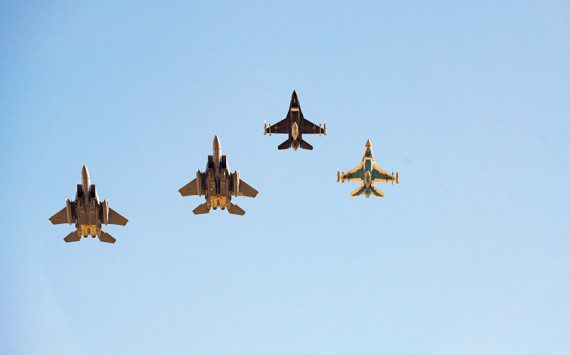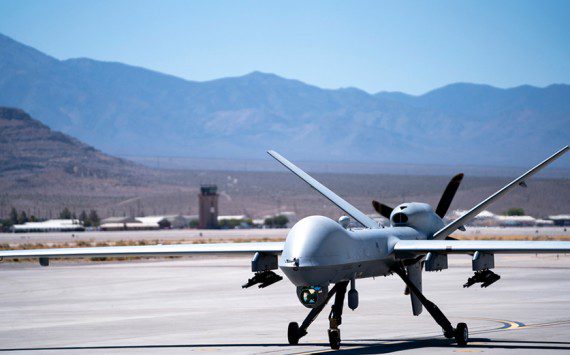The Mike O’Callahan Federal Medical Center provides medical treatment for Airmen and families at Nellis Air Force Base, Nev., April 1. The Mike O’Callahan Federal Medical Center, partnering with Veteran Affairs, will become the first Critical Care Unit in the Air Force to install a new virtual care team known as the Tele-ICU early next year.
NELLIS AIR FORCE BASE, Nev. — For Airmen working in a hospital’s intensive care unit, getting a second opinion from an experienced physician serves as an invaluable commodity.
Airmen at the Mike O’Callahan Federal Medical Center on Nellis Air Force Base will have that opportunity thanks to a partnership with Department of Veterans Affairs to bring the first Tele-ICU to the Critical Care Unit on base.
“The Tele-ICU is a way to use an audio and visual computer network to fill gaps in coverage and offer a second set of eyes to intensive care units,” said Matt Geode, M.D., VA associate medical director. “There’s a central hub in Minneapolis, with nurses and physicians that monitor patients with rooms wired with a video camera, video monitor, speakers and microphones so that they can teleconference in if necessary.”
From this central hub, doctors and nurses can observe and assist residents that are on site with patients in real time.
“We have access to all military sites and monitoring equipment that are in the ICUs,” said Kay Clutter, VA operations director. “We can see wave forms that come across, we see hemodynamics that come across and we can basically see everything that physicians see. We can observe when a patient is starting to crash or not look so well, and sometimes we’ll see it before the bedside physicians because of alerts we get on that patient. At that point in time, we’re able to camera into the room, ring the bell and take a look at the patient with our high definition cameras. With our view of the patient, we’re able to act as a decision support tool for the physician on-site.”
This support tool offers all those working in the Critical Care Unit new options to improve patient care.
“Tele-ICU nurses can focus on multiple patients, specifically stable patients, so nurses on-site can focus on a patient that isn’t doing as well,” said Clutter. “For a site like this that has residents, it gives them someone 24/7 who’s a certified critical care physician. Residents can talk with them, discuss the patients and discuss the care, making sure they’re making the correct decisions.”
With this new system providing physicians the ability to increase care for patients, the Tele-ICU lines up with what the Air Force Medical Service is attempting to accomplish on multiple platforms.
“The Air Force Medical Service is now on a journey to become a high reliability organization, which is a commitment to minimize any harm that we do to patients even more,” said Col. Patrick Danaher, Air Force Medical Operations Agency chief internal medicine consultant. “The long term, and main, goal is to have zero harm to patients. We have doctors, nurses and technicians that have to deploy downrange, often coming from ICUs, to take care of critical care patients. We need them to be as busy as they can be while they’re here so they’re ready to deploy. The Tele-ICU compliments both of those missions perfectly. It allows nurses and technicians to benefit from the ability to take care of the patients with the expertise from the Tele-ICU.”
With this new technology being a multifaceted tool designed not only increase patient care, but also physician expertise, seeing it in a downrange environment is a very real possibility.
“The best way to describe it is similar to how we use remotely piloted aircrafts,” said Col. Charles Tedder, Air Combat Command chief medical modernization officer. “The downrange team launches the aircraft, then hands off to the team who handles the mission at Creech AFB, and when it comes to landing, Creech AFB hands it back. The hope for this is that once it’s a proven technology, we can supplement the care that is offered in downrange facilities, and forward operating bases that only have a handful of doctors and nurses. They can hand-off a stabilized patient to the remote capability that can monitor the patient allowing that FOB to concentrate on other patients, increasing our holding capability.”
To eventually move this technology to more bases and FOBs, AFMOA partnered with the VA in a Joint Incentive Fund pilot program.
“The process for a JIF is that you have to compete for that money and put in proposals that introduce innovative technology that is already proven in one place or another,” said Mr. Brian McCarty, Office of the Surgeon General panel chair of medical modernization. “After a two-year period of time if we’ve shown positive metrics then we would look at expanding other ICUs. There are only seven ICUs in the Air Force, five being tied to this site, and if we are successful in this pilot there could be an expansion of ICUs to smaller sites.”
Five of the existing Air Force ICU sites are tied to MOFMC, the base acts as a perfect place to start the program.
“The partnership with Nellis came at the perfect time as we were looking for our next base for expansion,” said Clutter. “We already have 14 or 15 VA sites, so for the VA it was good to spread out and attempt something different, such as the Tele-ICU. With Nellis getting veteran patients and the VA getting active duty at times it just made sense.”
The program will look to become operational April 2017, and act as a working experiment on how to increase patient care and how to better the technology for future use.
“If we’re in a shoe horn downrange we’re going to take care of our troops,” said McCarty. “We have to ask the question: ‘how are we going to do that?’ This is the perfect experiment for us to figure out how those patients flow, and all those things that have to be done, so that when we get down range we will know just how it will work.”












